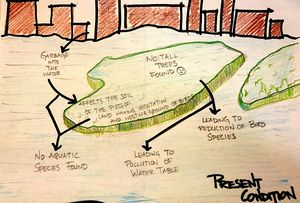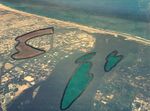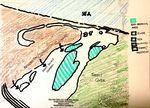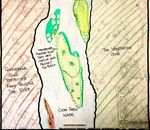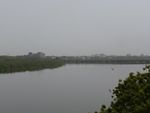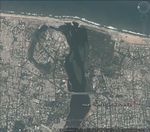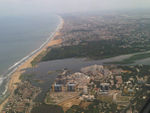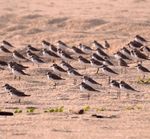Planting Design 2013 Working Group 27 - Case Study D
Adyar Estuary, River - An Environmental Failure
(Chennai,India)
Adyar Estuary and Creek and the Theososphical Society on the Estuary's southern side has been a heaven for migratory and resident birds for years. There were 70 migratory species from Asia and 50 indian species which were breeding here. The environmental conditions in the estuary with low salinity, good shelters and high plankton availability in the Adyar creek serves as a good nursery for fish. The flow of tidal water in and out of the creek allowed for easy travel of boats. It therefore encouraged fishing as well. However, with the city's sewage and effluence affected the river to a large extent. Now the river is converted into a sewage dumping area. There is no usage of boats and no fishing. So this area is a very important Environmental Protection area and has to be brought to attention to the Government Officials.
| Name | Adyar River | |
| Location | Chennai | |
| Country | India | |
| Authors | Saranya Gunasekaran | |
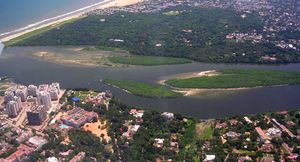
| ||
|
| ||
Rationale: Why is this case interesting?
I am documenting this case from the Environmental point of view and the further planning of the estuary which will improve the existing situation of the Scenario. There is a project sanction from the government of the State in 2007, but the process is too slow that it is still not into effect. One more worrying factor is that, even the funding is ready but the tender is still going on a slow ride. The shock about this case is that, a trust was formed in 2006 for this purpose called the --Chennai River Restoration Trust-- and till now only a very small portion or the Adyar creek has been redeveloped. Reports say that this has recovered the species and habitats to some extent. Still the river tends to breathe large amounts of sewage dumps in this area of the city. And I wish to propose a design to bring the area back to how it was earlier on the 1970s, which in turn helps in the restoration of the Flora, Fauna and Habitat which were present here
Author's perspective
I am documenting this case from the Environmental point of view and the further planning of the estuary which will improve the existing situation of the Scenario. There is a project sanction from the government of the State in 2007, but the process is too slow that it is still not into effect. One more worrying factor is that, even the funding is ready but the tender is still going on a slow ride. The shock about this case is that, a trust was formed in 2006 for this purpose called the --Chennai River Restoration Trust-- and till now only a very small portion or the Adyar creek has been redeveloped. Reports say that this has recovered the species and habitats to some extent. Still the river tends to breathe large amounts of sewage dumps in this area of the city. And I wish to propose a design to bring the area back to how it was earlier on the 1970s, which in turn helps in the restoration of the Flora, Fauna and Habitat which were present here.
Landscape and/or urban context of your case
Culture has a serious impact on nature in this case. Human impact on this estuary has created a very deteriorating effect on the ecosystem. The species both in the water body and in the small lands where the birds breed are totally in a bad condition. There are already no species in the water body due to high amount of sewage deposits in the river. Initially around 49 species of fish were recorded in the river. In the late 1970s it reduced to 21 species and now there are no fish in the river!
According to the ecological plan, floral species such as Indian almond, black wattle, sacred fig, madras thorn, Indian mulberry, neem, banyan, magizham, Indian cork tree, punnai, sirukkambil, karumugai, shenbagam, bayur tree, kadamba, pavazha malli, vetiver grass, palmorasa, agave, lemon grass and subabul would be part of species along the nature trail which would play a role in soil erosion management.
Analytical and Projective drawings
- Analytical Drawings
Summary and conclusion
Culture has a serious impact on nature in this case. Human impact on this estuary has created a very deteriorating effect on the ecosystem. The species both in the water body and in the small lands where the birds breed are totally in a bad condition. There are already no species in the water body due to high amount of sewage deposits in the river.
The approach to my project would be in the following order:
-to stop the flow of sewage into the river, thereby regaining the fresh water
- to improve and introduce vegetation which are native in that region which will help in the increase of bird species and will help in restoration of the land.
- to design in such a way that the birds feel secure while they breed here as this area is used for many decades as a breeding land for many migratory species.
Thus, the adyar river and the piece of islet in the river have to be considered as soon as possible so that further reduction of the number of species breeding there can be avoided. The removal of the overgrowing thorny plants and recreating the area with spaces for bird feeding and by artificially introducing the native species which were present before will bring the land the surroundings back to life. The mangroove planting also has to be carried out on the coastal regions and near the bridge area. I wish the work for cleaning the entire river which is presently a drainage dump will help and accelerate the betterment of the flora and fauna of the region.
Image Gallery
- Image Gallery
References
Chennai river restoration body
Bird species protection trusts
Adyar river history, chennai historical aspects
About categories: You can add more categories with this tag: "", add your categories
